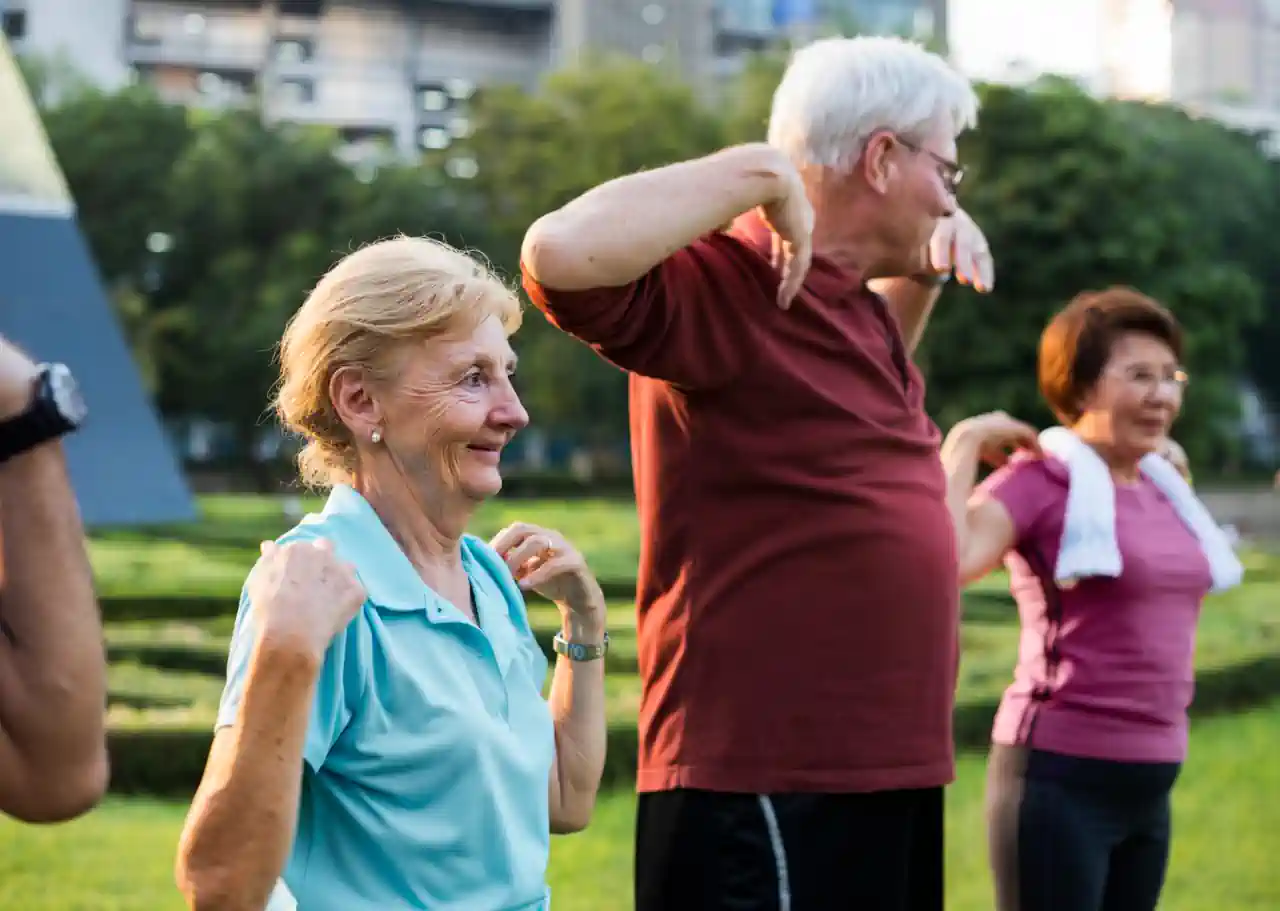As we age, it’s common for many individuals to become less active, leading a more sedentary lifestyle. However, staying physically active is crucial for maintaining good health, regardless of your age. In fact, for those aged 60 and above, regular physical activity becomes even more essential. Let’s explore why staying active after 60 is so important for your overall well-being.
Benefits of Physical Activity for Seniors
Maintaining Mobility
- As we age, our muscles tend to weaken, and joints may become stiffer. Regular physical activity helps maintain muscle strength and joint flexibility, allowing seniors to move more freely.
- Activities like stretching, yoga, and tai chi are particularly beneficial for improving flexibility and balance, reducing the risk of falls and injuries.
Heart Health
- Cardiovascular diseases are a leading cause of mortality among seniors. Physical activity strengthens the heart muscle, lowers blood pressure, and improves cholesterol levels.
- Engaging in aerobic exercises like brisk walking, swimming, or cycling can enhance heart health and reduce the risk of heart disease.
Mental Health
- Seniors often face unique mental health challenges such as depression, anxiety, and cognitive decline. Physical activity releases endorphins, which are natural mood lifters.
- Regular exercise has been linked to a lower risk of developing depression and anxiety disorders. It can also help in maintaining cognitive function and reducing the risk of conditions like dementia.
Weight Management
- Metabolism tends to slow down with age, making it easier to gain weight. Physical activity increases calorie expenditure and helps maintain a healthy weight.
- Combining cardiovascular exercises with strength training can be particularly effective for managing weight and building lean muscle mass.
Bone Health
- Osteoporosis, a condition characterized by brittle bones, becomes more prevalent as people age. Weight-bearing exercises, like walking or dancing, promote bone density and reduce the risk of fractures.
- Strength training exercises, such as lifting weights, can also strengthen bones and improve overall bone health.
Social Connection
- Loneliness and social isolation can have detrimental effects on seniors’ mental and emotional well-being. Participating in group activities or fitness classes can combat feelings of isolation.
- Engaging in physical activities with others provides opportunities for social interaction, fosters a sense of belonging, and can lead to new friendships.
Quality of Life
- Staying physically active enhances overall quality of life for seniors. It can improve sleep, boost energy levels, and increase overall vitality.
- Seniors who remain active often report a higher level of life satisfaction and a greater sense of purpose.
Chronic Disease Management
- Many seniors have chronic health conditions like diabetes, arthritis, or chronic obstructive pulmonary disease (COPD). Physical activity can help manage these conditions and improve symptoms.
- Exercise may reduce the need for medication in some cases and enhance overall health outcomes.
Physical activity is a powerful tool for seniors to maintain their physical and mental health, reduce the risk of chronic diseases, and enhance their quality of life. It’s never too late to start incorporating regular exercise into your routine, and the benefits are well worth the effort. Before starting a new exercise program, it’s advisable to consult with a healthcare provider to ensure that the chosen activities are safe and appropriate for your individual health needs.
Getting Started
Getting started with a new exercise routine, especially for seniors, requires some careful planning and consideration. Here’s a more detailed guide on how to start and maintain physical activity after the age of 60:
Consult Your Healthcare Provider
- Before beginning any new exercise program, it’s essential to consult with your healthcare provider, especially if you have underlying health conditions or haven’t been active for an extended period.
- Your doctor can help you identify any potential risks and provide guidance on the types and levels of exercise that are safe for you.
Choose Activities You Enjoy
- To ensure long-term commitment, select activities that you genuinely enjoy. Whether it’s walking, swimming, gardening, dancing, or even yoga, doing something you like will make it more likely that you’ll stick with it.
- Consider exploring a variety of activities to find what suits you best.
Set Realistic Goals
- Start with realistic and achievable goals. It’s essential to avoid setting overly ambitious targets that could lead to frustration or injury.
- Gradually increase the intensity, duration, and frequency of your workouts as you build your strength and endurance.
Incorporate Strength Training
- Strength training exercises are crucial for seniors because they help maintain muscle mass, improve metabolism, and support bone health.
- Start with light weights or resistance bands and gradually increase the resistance as your strength improves. Include exercises for all major muscle groups.
Warm Up and Cool Down
- Warm up your muscles before exercise with five to ten minutes of light activity, such as walking or gentle stretching.
- After your workout, cool down with stretching exercises to improve flexibility and reduce the risk of muscle soreness.
Stay Hydrated and Eat Well
- Proper nutrition and hydration are essential for energy and recovery. Ensure you’re drinking enough water before, during, and after exercise.
- Maintain a balanced diet that includes a variety of nutrients to support your physical activity.
Listen to Your Body
- Pay close attention to how your body feels during and after exercise. If you experience pain, discomfort, dizziness, or shortness of breath, stop the activity immediately and seek medical advice if necessary.
- It’s normal to feel some muscle soreness, but it should improve with time. If it persists or worsens, consult your healthcare provider.
Stay Consistent
- Consistency is key to reaping the long-term benefits of physical activity. Aim for regular exercise sessions, even if they are shorter in duration.
- If you miss a workout or face setbacks, don’t get discouraged. Stay committed to your goals and make adjustments as needed.
Consider Safety Precautions
- Depending on your chosen activities, you may need safety equipment, such as comfortable shoes, proper clothing, or protective gear.
- If you exercise outdoors, consider factors like weather conditions and visibility to ensure your safety.
Monitor Progress
Keep a journal or use a fitness app to track your progress. Document your workouts, how you feel, and any improvements you notice in strength, endurance, or mood. – Celebrate your achievements, no matter how small, to stay motivated.
Remember that it’s never too late to start an exercise routine, and the benefits for seniors are substantial. By following these guidelines and working with your healthcare provider, you can embark on a safe and enjoyable journey toward better health and well-being through physical activity.
Incorporating physical activity into your daily life, even after the age of 60, is essential for maintaining good health and quality of life. Regular exercise can help you stay mobile, keep your heart healthy, boost your mood, and so much more. Remember that it’s never too late to start, and small changes can make a big difference in your overall well-being.
So, lace up those sneakers, find an activity you love, and enjoy the numerous benefits of staying active as a senior.
Sources:
- Mayo Clinic. (2021). Exercise for weight loss: Calories burned in 1 hour. https://www.mayoclinic.org/healthy-lifestyle/weight-loss/in-depth/exercise/art-20050999
- Harvard Health Publishing. (2019). Exercise is an all-natural treatment to fight depression. https://www.health.harvard.edu/mind-and-mood/exercise-is-an-all-natural-treatment-to-fight-depression
- National Institute on Aging. (2021). Exercise and physical activity: Your everyday guide from the National Institute on Aging. https://www.nia.nih.gov/sites/default/files/2021-02/exercise_guide.pdf

